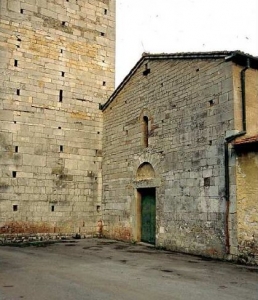
Information
Address:
Via delle scuole, 36, Sesto di Moriano, Lucca
Foundation:
VIII century
Telephone:
+39 0583 579212
District/Location:
Lucca, Sesto di Moriano
District:
Piana di Lucca


One of the oldest Parish Churches in the Lucca area, it had jurisdiction over a large territory extending along both banks of the River Serchio in the early middle ages. Preserved from its 11th century appearance, it still has an old christening font and a magnificent fresco in the apse, linked to Francesco Traini.
Lucca, Sesto di Moriano
Located in a strategic position on the river bank, near the Moriano Castle, the refuge and stronghold of bishop Anselmo besieged by the canons of S. Martino, it refused the radical reforms of life imperiously proposed by him. It had, from 762 (when it was recorded as a church), and 802 (when it was a Parish Church), a strong territorial development, to then see most of its dependent churches detach and form part of the new parish of Brancoli in the 11th century.
The name S. Giovanni Battista was added to that of S. Maria, as was customary for baptismal Parish Churches. Today it is known by this name alone, although mass is no longer celebrated there, while the title of S. Maria passed to the new church that replaced it in the 16th century. The construction of the new building is possibly connected to the fact that the Parish Church of Sesto together with that of Monsagrati had passed under the jurisdiction of the De Nobili family, with a notarial act from 1496, later confirmed by a Papal Bull in 1517.
The single nave building with apse, similar to the churches of S. Lorenzo in Corte di Brancoli and S. Maria in Piazza, is today closed to worship and used as a parish hall.
The apsidal basin has a fresco of a Benedictory Christ attributed to the Maestro of San Frediano, possibly the most interesting artist on the scene in Lucca in the first half of the 14th century. This name relates to his being the author of the frescos in the counter-façade of the town basilica. There is also a simple, 12th century christening of interest.
To the medieval building with the bell tower next to the façade, the now active church to the left was added in the 16th century, also in a medieval style.
This church was subsequently enlarged in the 18th and 19th century with the addition of two side chapels. The presbyterial area features frescos by Bartolomeo de Santi of fake architecture. The high-altar has an Assumption of the Virgin by Alessandro Ardenti, while the side altars feature two paintings, a Crucifixion and a Virgin and Child with Saints, in the style of Ippolito Sani and Paolo Biancucci.
From the 12th century, in the nearby "ecclesia Sancti Sani" (Sant´Ansano), a cultural centre developed that drew masses of parishioners and pilgrims, especially those in search of healing for ailments of limbs and joints.
The name S. Giovanni Battista was added to that of S. Maria, as was customary for baptismal Parish Churches. Today it is known by this name alone, although mass is no longer celebrated there, while the title of S. Maria passed to the new church that replaced it in the 16th century. The construction of the new building is possibly connected to the fact that the Parish Church of Sesto together with that of Monsagrati had passed under the jurisdiction of the De Nobili family, with a notarial act from 1496, later confirmed by a Papal Bull in 1517.
The single nave building with apse, similar to the churches of S. Lorenzo in Corte di Brancoli and S. Maria in Piazza, is today closed to worship and used as a parish hall.
The apsidal basin has a fresco of a Benedictory Christ attributed to the Maestro of San Frediano, possibly the most interesting artist on the scene in Lucca in the first half of the 14th century. This name relates to his being the author of the frescos in the counter-façade of the town basilica. There is also a simple, 12th century christening of interest.
To the medieval building with the bell tower next to the façade, the now active church to the left was added in the 16th century, also in a medieval style.
This church was subsequently enlarged in the 18th and 19th century with the addition of two side chapels. The presbyterial area features frescos by Bartolomeo de Santi of fake architecture. The high-altar has an Assumption of the Virgin by Alessandro Ardenti, while the side altars feature two paintings, a Crucifixion and a Virgin and Child with Saints, in the style of Ippolito Sani and Paolo Biancucci.
From the 12th century, in the nearby "ecclesia Sancti Sani" (Sant´Ansano), a cultural centre developed that drew masses of parishioners and pilgrims, especially those in search of healing for ailments of limbs and joints.
Scopri altre attrazioni vicino a Saint Mary of the Assumption
See allYou may also like..
See allFind more
0











